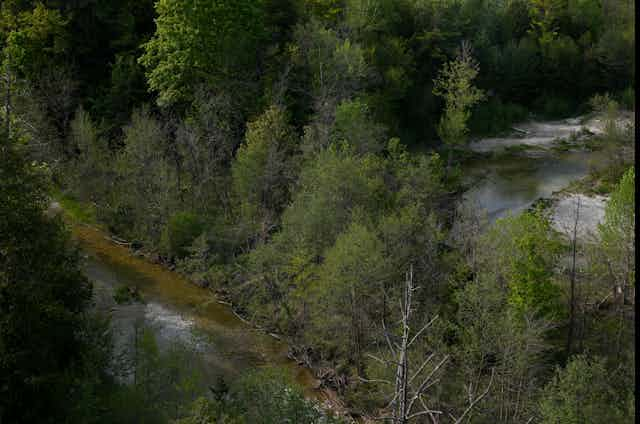Ontario Premier Doug Ford’s government continues to be tied up in a massive scandal over its plans to remove lands from Ontario’s Greenbelt — including the integrity commissioner’s finding that the housing minister broke ethics rules.
Indeed, as world leaders gathered in Vancouver on Aug. 24 to launch a “game-changing” global fund to fight biodiversity loss, Ford was already leading Canada’s most populous province in a very different direction.
Political controversy aside, what has become abundantly clear is that Ford’s Greenbelt plans fly in the face of Canada’s freshly funded commitment to halt biodiversity loss.

Stretching over two million acres, the Greenbelt is the largest protected area of its kind in the world. It includes some of Ontario’s best farmland as well as over seven hundred thousand acres of wetlands, grasslands and forests.
With the climate change crisis fuelling devastating wildfires, droughts and heat waves, it can be easy to forget that we are also living through a global biodiversity crisis.
So, what exactly is it that we gain from biodiversity — and what does protecting lands like the Greenbelt have to do with it?
Nature’s interconnected benefits
Ecosystem services are the benefits we get from the natural environment. It is a long list that includes everything from the foods we eat and the clean air we breathe to the simple joy of walking through the woods.
These services are usually divided into three main groups: provisioning, regulating and cultural services.
Provisioning services give us the physical things we need, like the plants and animals we eat, clean water to drink and plant life that provide things like oxygen, lumber and paper. Nature provides these vital resources. Even modern food industries still ultimately rely on the health of both agricultural and natural ecosystems.
Agricultural systems rely on regulating services like erosion protection, pollination and pest control. Regulating services, as the name suggests, regulate environmental conditions, including the climate and the water cycle.

A better-known example of this kind of service is carbon sequestration: the process of capturing and storing atmospheric carbon dioxide. It is a key climate regulation process that natural lands provide.
The Greenbelt scoops up an estimated 71 million tonnes of carbon annually. For context, the average Canadian is responsible for about 20 tonnes of carbon entering the atmosphere over the same period.
Wetlands are another example of a regulating service. The soils and plants in wetlands — some of which are targeted for removal from the Greenbelt — take up water and absorb carbon and other pollutants. This offers not only flood control, but also helps to clean both the water and air.
Read more: Pollution timebombs: Contaminated wetlands are ticking towards ignition
Finally, cultural services capture the spiritual, historical and cultural significance of certain natural lands and ecosystems. These services also include things like recreation, aesthetics and the general improvements to our well-being that come from being in or around nature — and cultural services are particularly important for Indigenous Peoples.
With over nine million people living within 20 kilometres of the Greenbelt, it provides a space for nearly a quarter of Canada’s population to enjoy these benefits.
A diverse support system
Biodiversity supports these ecosystem services, helping to keep natural processes working. Not all environments will provide the same services and having several types of ecosystems helps to maintain the wide variety of services we need — a type of biodiversity called ecosystem diversity.
In a healthy, resilient ecosystem, many different species will perform the same function, something known as “functional diversity.” For example, there are many different insects — bees, butterflies, beetles and more — that pollinate flowering plants. With many species doing the same job, the ecosystem can keep humming along even if one is impacted by disease, droughts or heat waves.
Genetic biodiversity — the variety of genetic material that exists within a species — is the basis for natural selection. It allows species to evolve and survive in changing environments — something that is increasingly important in a warming world.
The Greenbelt is home to 78 species at risk. Several of these species are located on the parcels of land slated to lose their protections, including barn owls, the eastern meadowlark and Blanding’s turtle.
The land-use battle
The leading driver of biodiversity loss is the destruction of habitats due to changes in land use, mainly for agricultural purposes and general urbanization.
This is what world leaders are trying to curtail with the launch of the Global Biodiversity Framework Fund in Vancouver this past week — with Canada pledging $200 million dollars to the cause.
Unfortunately, this type of habitat destruction is also exactly what is being proposed for the Greenbelt.

The issue is not only about the amount of land that is protected, but also where it is and its connection to other natural areas. The fragmentation of ecosystems — where natural lands are divided into smaller, isolated patches — restricts the movement of species and can impact both functional and genetic diversity.
The current setup of the Greenbelt helps to prevent fragmentation by connecting landscapes, allowing wildlife to move between different areas. Slicing out one chunk of protected land and passing those protections elsewhere could destroy this.
Read more: Protecting biodiversity – and making it accessible – has paid off for Costa Rica
Ultimately, biodiversity plays a vital role in supporting the ecosystem services we, and all life on earth, rely upon and will become even more important as we face a changing climate.
In the face of distracting political controversy it is easy to lose sight of a more fundamental fact: that preserving the Greenbelt — and Canadian biodiversity in general — is essential to our ongoing survival.

